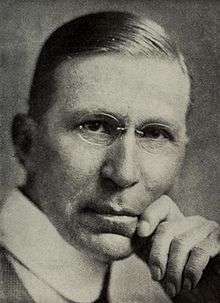Adolph C. Miller
Adolph Caspar Miller (January 7, 1866 - February 11, 1953) was an American government official and university professor. He was one of the original Governors of the Federal Reserve System, appointed in 1914, and served in that capacity for 22 years. He was a notable benefactor of the University of California, Berkeley, of which he was a graduate.
Adolph Miller | |
|---|---|
 | |
| Member of the Federal Reserve Board of Governors | |
| In office August 10, 1914 – February 3, 1936 | |
| President | Woodrow Wilson Warren G. Harding Calvin Coolidge Herbert Hoover Franklin D. Roosevelt |
| Preceded by | Position established |
| Succeeded by | John McKee |
| Personal details | |
| Born | Adolph Caspar Miller January 6, 1866 San Francisco, California, U.S. |
| Died | February 11, 1953 (aged 87) Washington, D.C., U.S. |
| Political party | Independent |
| Education | University of California, Berkeley (BA) Harvard University (MA) |
Early life
Miller was born in San Francisco on January 7, 1866. After receiving his degree from the University of California, he studied abroad in Paris and Munich[1] Miller served as an instructor at Harvard University, and then spent one year each as an assistant professor at his alma mater and at Cornell University before being hired as a full professor of finance at the University of Chicago. While in Chicago, in 1895, Miller married Mary Sprague, daughter of a prominent Chicago businessman.
University and political career
In 1902, Benjamin Wheeler, President of the University of California, persuaded Miller to return to Berkeley as Flood Professor of Finance, and to take charge of the College of Commerce, predecessor of today's Haas School of Business. Miller remained there until 1913. In that year, Miller's classmate and friend, Franklin Knight Lane was appointed as Secretary of the Interior by Woodrow Wilson, and Lane persuaded Miller to come to Washington to serve as Assistant Secretary.[1] In May 1913, Miller was also appointed as Director of the Bureau of National Parks.[2]
In 1914, Miller was appointed one of the original governors of the Federal Reserve System, which had been established late the previous year.[3] The terms of the initial governors were staggered, and Miller received the longest initial term, ten years.[3] Miller was the sole economist on the Board during World War I, and he supported policies which would reduce spending by the public, principally through higher taxes.[4]
He served 22 years in that capacity before retiring in 1936. He remained a significant benefactor to the University of California, and its Miller Institute for Basic Research in Science was both endowed by money left to the University, and named for him.[1]
His house in the Kalorama neighborhood of Washington DC, designed in 1924 by Baltimore architect Hall Pleasants Pennington, still stands at 2230 S Street NW.[5]
References
- About the Miller Institute, Miller Institute
- The Letters of Franklin Lane, Houghton Mifflin Co., 1922, p. 139
- "201. Appointment Of Federal Reserve Board". Retrieved 19 March 2017.
- Wells 2004, pp. 30–31.
- Emily Hotaling Eig and Julie Mueller, Traceries (1989). "National Register of Historic Places Registration Form: Sheridan-Kalorama Historic District".
Bibliography
- Wells, Donald (2004), The Federal Reserve System, McFarland, ISBN 0-7864-1880-X